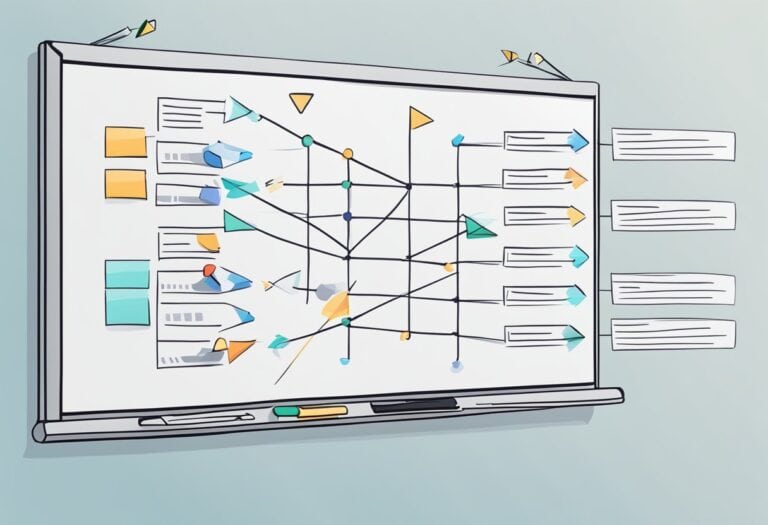The TRIZ method, an acronym derived from the Russian “Teoriya Resheniya Izobretatelskikh Zadach,” translates to the “Theory of Inventive Problem Solving.”
Developed by Soviet engineer and researcher Genrich Altshuller and his colleagues, it represents a systematic approach to understanding and solving complex problems and challenges.
The methodology is rooted in a comprehensive analysis of patent databases to decipher patterns and principles behind inventive processes, positing that the evolution of systems follows certain laws.

TRIZ encompasses a set of tools, principles, and a problem-solving process that encourages users to think outside their domain of expertise. By framing problems in terms of contradictions and employing abstract solutions that have proven effective across various industries, it facilitates innovative thinking that transcends conventional approaches.
The TRIZ method has thus found applications across numerous fields, instigating creative solutions and streamlining the process of invention.
Key Takeaways
- TRIZ is a method for creative problem-solving based on the analysis of patents to identify universal principles of innovation.
- The methodology employs a systematic process which includes identifying and solving contradictions to foster inventive thinking.
- TRIZ offers tools and techniques that are widely applicable across different industries to enhance creativity and innovation.
Origins of the TRIZ Method
The TRIZ method, a systematic approach to problem-solving, was conceptualized and developed in the mid-20th century. It stands as a testament to human ingenuity, specifically within the context of the Soviet Union’s scientific community.
Genrich Altshuller and the Soviet Union
Genrich Altshuller, a Soviet inventor and science fiction writer, laid the foundations for the TRIZ method. In 1946, while employed in the “Inventions Inspection” department of the Caspian Sea flotilla, Altshuller began to analyze and categorize patterns in patents.
He scrutinized numerous inventions, seeking universal principles that underpin innovative solutions to complex problems. His extensive research across a vast array of patents revealed that inventive solutions could be systematically derived from understanding these principles.
Operating under the governance of the Soviet Union, where innovation and scientific progress were highly prized, Altshuller and his colleagues pursued the development of the Theory of Inventive Problem Solving. Over time, they formulated TRIZ as a robust methodology, leveraging patterns identified in worldwide patent literature to inform the creative process. Their efforts culminated in a structured method that could guide inventors and scientists to solve problems creatively and efficiently.
Principles of TRIZ
The TRIZ method is based on the concept that universal principles of invention underlie all creative solutions to problems. Understanding and applying these principles can aid in resolving contradictions and lead to innovative ideas.
Contradictions and Inventive Principles
The foundation of TRIZ lies in the identification and resolution of contradictions. Typical problems often involve conflicts where improving one feature results in the degradation of another. The TRIZ methodology outlines a systematic approach to these contradictions through the use of inventive principles.
40 Inventive Principles
At the core of TRIZ are the 40 Inventive Principles, a tool designed to resolve the identified contradictions. Each principle represents a generic solution to a problem, drawn from the analysis of thousands of patents. Here are some key principles representative of the 40:
- Segmentation: Divide an object into independent parts.
- Local Quality: Change the structure of an object from uniform to non-uniform.
- Asymmetry: Transition from symmetrical to asymmetrical shapes.
- Merging: Bring closer together or merge identical or similar objects.
The principles are applied to direct the problem solver towards innovative solutions that someone, somewhere, has likely used before in a different context.
TRIZ Problem-Solving Process
The TRIZ problem-solving process is a systematic approach, structured to navigate through the complexity of inventive problems by identifying and resolving contradictions with innovative solutions. Utilizing a set of tools and techniques, it helps users apply its 40 inventive principles to generate and implement solutions effectively.
Problem Identification
In the initial stage, the focus is on uncovering the real issue at hand. This involves detecting the specific area of conflict or the contradiction that hinders the system from reaching its ideal state. Problem identification is critical because a correctly identified problem steers the course of the entire TRIZ methodology.
Problem Formulation
Once identified, the problem needs to be formulated using TRIZ terminology and principles. This involves distilling the problem down to its most basic components, often highlighting the inherent contradictions. The problem formulation stage sets a clear path forward by developing a precise statement of the problem to tackle.
Solution Generation
The core of the TRIZ process lies in solution generation. This phase uses the 40 inventive principles and a suite of tools—like the contradiction matrix—to guide thinkers in creating novel solutions. By examining similar problems across different industries and disciplines, users can uncover analogous solutions that can be adapted to their specific challenge.
Solution Implementation
Finally, the selected solution must be adapted and implemented within the original context. This demands careful planning and execution to ensure that the solution resolves the identified contradictions without creating new problems. Solution implementation bridges the gap between theory and practice, actualizing the creative potential of the TRIZ approach.
TRIZ Tools and Techniques
In the realm of the TRIZ methodology, specific tools and techniques are employed to guide problem solvers in overcoming obstacles and reaching innovative solutions. These include the widely used Contradiction Matrix and the comprehensive set of 76 Standard Solutions.
Contradiction Matrix
The Contradiction Matrix is central to the TRIZ process. It is a tool that assists in identifying and solving inherent contradictions within a system or product.
By referencing a matrix of 39 engineering parameters, problem solvers can pinpoint the exact nature of their design or functional conflict and apply one or more of the 40 TRIZ principles to resolve it.
This matrix simplifies the challenge of innovation by providing a structured approach to navigate through common obstacles that impede technical progress.
76 Standard Solutions
TRIZ also incorporates a set of 76 Standard Solutions, which are systematic approaches categorised into five groups to defuse more complex or subtle contradictions.
These solutions are distilled from a vast analysis of inventive patents and offer a toolkit to innovate through difficult problems that may not be solved with the contradiction matrix alone.
The Standard Solutions encourage looking at a problem from multiple angles, employing high-level strategies such as changing an object’s structure or its interaction with the environment to achieve a breakthrough.
Applications of the TRIZ Method
The TRIZ method has been instrumental across various sectors, enhancing innovation and problem-solving capabilities. Here, specific examples within industries and companies like Ford, Samsung, and Boeing showcase the method’s versatility and effectiveness.
Innovation in Industries
TRIZ paves the way for industrial innovation, serving as a catalyst for creative advancements within prominent companies. Industries ranging from automotive to electronics benefit from TRIZ by identifying and resolving contradictions without compromise.
At Ford, this methodology supports the design of more efficient manufacturing systems. Similarly, LG and Samsung leverage TRIZ principles to fuel their continual quest for innovative consumer electronics, leading to smarter, more intuitive products.
Technology and Engineering
In the realm of technology and engineering, TRIZ provides a structured approach for innovative problem-solving. Intel applies TRIZ for semiconductor processing advancements, while Rolls-Royce uses it for jet engine improvements, leading to more powerful and efficient designs.
TRIZ is particularly effective in companies where engineering challenges are complex and demand non-obvious solutions, which makes it a favorite at enterprises like Hewlett-Packard and General Electric.
Product Development and Process Management
TRIZ has profoundly impacted product development and process management. By systematically analyzing patterns of invention within a field, companies generate creative solutions and enhance product features.
For instance, Kodak applied TRIZ methods to solvent recycling processes, improving environmental and cost metrics. Motorola and Boeing, too, have integrated TRIZ into their process management strategies, resulting in streamlined operations and increased industry competitiveness. This solidifies TRIZ as a powerful tool in the continuous improvement of products and services.
Impact of TRIZ on Creativity and Innovation
The TRIZ method offers a structured approach, enhancing the problem-solving capabilities that are crucial to creativity and innovation. It systematically addresses challenges by reframing problems and aiding in the collaboration of ideas.
Enhancing Creativity Through Structured Problem-Solving
TRIZ promotes a structured problem-solving process, which is instrumental in enhancing an individual’s or organization’s creativity.
By representing problems as contradictions, TRIZ steers clear from the randomness of traditional brainstorming, allowing for a more directed and efficient attack on issues.
The method introduces general principles that undergird various solutions across disciplines, aiding users in learning to connect disparate pieces of knowledge.
The outcome is an increase in creativity, not through spontaneous eureka moments, but via a step-by-step methodology that can be learned and replicated.
Overcoming Challenges with TRIZ
With TRIZ, challenges in innovation become more manageable. By equipping users with tools to identify and resolve fundamental contradictions, TRIZ tackles one of the hardest parts of the innovation process.
Teams can collaborate more effectively, as the common language and framework TRIZ provides helps to synthesize diverse perspectives. As a result, TRIZ empowers organizations to streamline the innovation process, reducing the costliness of trial and error and facilitating the generation of breakthrough ideas.
Advanced TRIZ Concepts
In the advanced application of the TRIZ method, practitioners focus heavily on overcoming Physical Contradictions and incorporating Scientific Effects and Innovations to propel technical evolution and produce innovative solutions.
Physical Contradictions
Physical Contradictions are situations where an object or system requires mutually exclusive conditions to meet different needs. TRIZ addresses these by applying inventive principles that lead to the separation of contradictory requirements in time, space, upon condition, or between part and whole. For instance, a material that needs to be both strong and flexible can be approached by segmenting the structure so that parts of it are strong while others are flexible.
Scientific Effects and Innovations
Delving into Scientific Effects and Innovations, TRIZ leverages various fields of science to solve engineering and design problems.
It systematically catalogs scientific phenomena, such as thermal effects or electromagnetism, to be used as potential solutions for technical challenges.
The methodology encourages looking outside a specific domain for solutions that have been realized in other areas, thus fostering innovative solutions and contributing to the technical evolution of products and processes.
Implementing TRIZ in Organizations

Organizations seeking to foster innovation adopt the TRIZ method as a systematic approach to creative problem solving. This technique provides a structured way to approach challenges, offering tools that harmonize innovation with technical systems.
TRIZ in Corporate Training
To effectively integrate the TRIZ method into an organization, corporate training programs are often developed. These programs typically involve teaching key principles of the TRIZ method as well as the its 40 inventive principles and 76 standard solutions.
Employees are trained to utilize these tools to identify and solve problems in a systematic manner. For example, technology companies often begin by creating introductory TRIZ programs, which are designed to cultivate a foundational understanding among their staff, with the ultimate goal of prompting technical innovation and process improvement.
Collaboration and Learning
A central facet of implementing TRIZ within an organization involves fostering a culture of collaboration and learning.
When employees work together under the TRIZ methodology, they are encouraged to pool their collective expertise to overcome conflicting requirements or ‘contradictions’ in projects or processes.
Learning from various branches of the company enhances systemic problem-solving capabilities and applies collective intelligence to the arriving at inventive solutions.
Such collaborative efforts are supported by TRIZ’s emphasis on finding general solutions to general problems and can be particularly effective when different departments within an organization share and expand upon each other’s ideas.
Comparative Analysis
Before engaging in a detailed comparison, it is crucial to understand that TRIZ, as a systematic and inventive problem-solving methodology, diverges considerably from more conventional approaches. It is rooted in the identification and application of principles that others may overlook.
TRIZ Versus Other Problem-Solving Methods
TRIZ stands out for its structured framework that is built upon a collection of inventive principles and patterns observed in successful innovation across various industries. Contrary to more traditional problem-solving methods, it focusses on identifying the ideal solution first and works backwards to solve the problem.
- Lateral Thinking: Often associated with creativity, lateral thinking encourages alternative ways of looking at problems. While lateral thinking promotes divergence in thought, TRIZ once again provides a structured approach, aiming to streamline the creative process through predefined inventive principles and patterns.
- Root Cause Analysis (RCA): RCA is a method aimed at identifying the underlying causes of a problem. Where RCA tends to be more linear and focused on past data, TRIZ is predictive and forward-looking. It seeks to not only address the immediate issue but also forecast future challenges and preemptively offer solutions.
- Morphological Analysis: This is a method to solve complex problems by breaking them down into their constituent parts. In comparison, TRIZ uses a series of 40 innovative principles, which can be a more efficient way to generate solutions without analyzing every potential variation as in morphological analysis.
- SIT (Systematic Inventive Thinking): Both SIT and TRIZ are systematic, but TRIZ is more comprehensive as it incorporates the analysis of vast amounts of patent information to guide the problem-solving process. SIT, while systematic, doesn’t take advantage of this extensive historical innovation data.
Through TRIZ, one can rapidly match existing solutions to current problems, making it possible to bypass the trial-and-error phase often found in other methodologies. This becomes a substantial advantage when facing complex challenges, as it considerably reduces the time and effort required to innovate.
Case Studies and Success Stories
Exploring the real-world applications of TRIZ, numerous global corporations have integrated this method to solve complex problems and innovate. Case studies demonstrate how these companies leverage TRIZ principles to enhance creativity and efficiency in product development and process improvement.
Case Studies in Global Corporations
General Electric (GE) utilized TRIZ to tackle engineering challenges, resulting in streamlined processes and innovative product designs. By applying TRIZ methodologies, they effectively generated solutions for cross-disciplinary technical issues.
Ford Motor Company has incorporated TRIZ in their approach to resolve manufacturing problems and enhance their automotive design processes. This led to cost savings and reduced time-to-market for new vehicle features tailored to customer needs.
Samsung applied TRIZ to improve its product development across various departments. It helped them in systematically identifying and solving key technical and process-related obstacles, thereby fostering a culture of innovation.
Rolls-Royce has been known to use TRIZ for boosting their engine design efficiency. By leveraging TRIZ strategies, they were able to identify inventive solutions and improve overall engine performance.
Boeing, in their quest for excellence in aerospace engineering, has included TRIZ in their toolbox for inventive problem solving. This has aided them in overcoming complex design challenges and advancing their technology.
Hewlett-Packard (HP) integrated TRIZ as part of their innovation practices. It was especially beneficial in their product development cycle, increasing the pace of innovation and reducing costs.
At Motorola, TRIZ has played a significant role in improving their product designs and manufacturing processes. It enabled Motorola to navigate complex challenges and streamline various operational aspects to improve efficiency and effectiveness.
The Future of TRIZ

The TRIZ methodology, with its robust problem-solving capabilities, is poised to undergo significant changes as it adapts to contemporary industry needs and integrates with modern technological advancements.
Evolution and Adaptation of TRIZ in Modern Times
The Theory of Inventive Problem Solving, commonly known as TRIZ, will continue to evolve, ensuring relevance in increasingly complex innovation landscapes. As industries grapple with pressing triz contradictions—where improving one aspect of a system results in the degradation of another— TRIZ’s ability to navigate these challenges becomes even more critical.
Companies will likely adapt TRIZ in several key ways to embrace the nuanced demands of technical evolution. The method may leverage advancements in artificial intelligence and machine learning to analyze patterns of invention automatically. This could lead to the generation of new principles that contemporize Altshuller’s original set, which may better address the sophisticated technologies of the digital age—like quantum computing and nanotechnology.
Integration with other innovation methodologies such as agile development processes and lean practices could also enhance the iterative and user-centered approaches to solving engineering dilemmas. By interfacing with these frameworks, TRIZ practices will not only solve problems but also streamline product development cycles, optimizing efficiency while fostering creativity.
In summary, the future of TRIZ will reflect a dynamic approach that melds its established principles with transformative technologies and methodologies. This harmonization promises to accelerate the pace of technical evolution and innovation, solidifying TRIZ as an indispensable tool for problem solvers and inventors.
Additional TRIZ Strategies

In TRIZ problem-solving methodology, various strategies enable innovators to systematically approach complex problems. Among these strategies, Segmentation, Dynamics, and Parameter Changes are instrumental in devising creative solutions.
Segmentation
Segmentation involves breaking down an object or system into its independent parts. The goal is to make an object more manageable by separating it into its constituents. For instance, a complex machine could be segmented into detachable sub-assemblies to simplify maintenance and repair. This strategy aligns with the principle of periodic action, where disassembling a system can facilitate intermittent operation or maintenance.
Dynamics
The Dynamics strategy in TRIZ focuses on allowing or designing systems to change over time or to operate under different conditions. It’s about enabling adaptability in the system’s structure or functions to meet changing needs. A dynamic approach might include designing a machine that can adjust speeds or operations autonomously based on sensory input. The concept of partial or excessive actions is related here, in that a system may adapt by partially increasing or reducing some of its functions in response to situational requirements.
Parameter Changes
Under Parameter Changes, the emphasis is on altering an object’s physical or chemical parameters to improve its performance or capabilities. For example, changing the material properties such as temperature, pressure, or concentration can lead to significant enhancements. This strategy often involves modifications that trend towards optimal operational parameters, seeking out the points at which components or systems function most effectively.
Frequently Asked Questions
The TRIZ method offers systematic approaches to problem-solving, fostering innovation and aiding inventors or businesses in developing new products and processes.
How does the TRIZ method facilitate innovation?
The TRIZ method stimulates innovation by systematizing the problem-solving process. It provides tools and principles that guide users to think creatively and identify solutions that transcend conventional thinking.
Can you provide an example of the TRIZ method applied in a practical scenario?
An example of TRIZ in action is when a manufacturer confronts the issue of a product that must be strong yet lightweight. TRIZ principles would redirect the focus on resolving this contradiction, therefore leading to innovative material choices or design changes.
What are the main principles underlying the TRIZ method?
The main principles that form the foundation of the TRIZ methodology include identifying and resolving contradictions, system evolution patterns, and the use of ideality and resource analysis to conceive novel solutions.
How is the TRIZ method implemented in problem-solving processes?
The TRIZ method is implemented in problem-solving by first defining the problem in terms of contradictions and then systematically exploring solutions using a variety of TRIZ tools, such as the Algorithm of Inventive Problem Solving (ARIZ).
What tools and resources are integral to the TRIZ method, such as the Contradiction Matrix?
Central to the TRIZ method is the Contradiction Matrix, which helps to pinpoint inventive solutions based on similar problems across different fields. Other resources include the 40 Principles of Invention and the use of scientific and engineering phenomena.
How can the TRIZ method enhance research and development strategies?
The TRIZ method can significantly enhance research and development by providing a structured approach to creativity, thereby reducing aimless trial-and-error processes and encouraging the systematic exploration of innovative avenues.





